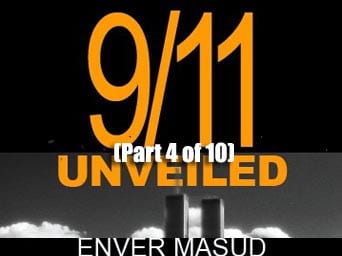by Enver Masud
On September 12, 2001 ABC News reported that “investigators have identified all the hijackers”.
Among those identified was “Satam Suqami, a Saudi national on American Airlines Flight 11, whose passport was [miraculously] recovered in the rubble.”
The next day, FBI Director Robert S. Mueller announced that the FBI had “identified most of the hijackers responsible”. Mueller is reported to have said (CBS, 60 Minutes II, September 10, 2003):
A flight attendant on American Flight 11, Amy Sweeney, had the presence of mind to call her office as the plane was hijacked and give them the seat numbers of the hijackers.
Peter Finn and Charles Lane wrote that an attendant on Flight 11 used a cell phone (Washington Post, October 6, 2001), but six years later, the FBI admitted that two low-altitude calls from Flight 93 were the only cell phone calls made from all four of the 9/11 planes (Griffin, Canadian, October 8, 2007).
If an Airfone was used, billing records could provide confirmation of Sweeney’s phone call.
On September 21, 2001, Nick Hopkins of the Guardian reported:
After analysis of the passenger lists of the four hijacked flights and other immigration documents, investigators identified Salem Al-Hazmi and Abdulaziz Al-Omari as two of the terrorists.
The real Salem Al-Hazmi, however, is alive and indignant in Saudi Arabia, and not one of the people who perished in the American Airlines flight that crashed on the Pentagon
On September 23, 2001 BBC News reported that four of the hijack “suspects”—Waleed Al Shehri, Abdulaziz Al Omari, Saeed Alghamdi, and possibly Khalid Al Midhar were—alive, and Director Mueller acknowledged “that the identity of several of the suicide hijackers is in doubt.”
The same day, David Harrison of the Telegraph reported:
The men—all from Saudi Arabia—spoke of their shock at being mistakenly named by the FBI as suicide terrorists. None of the four was in the United States on September 11 and all are alive in their home country.
On September 17, 2001, the Associated Press published passenger lists for AA Flight 11, UA Flight 175, AA Flight 77, and UA Flight 93, based on information supplied by “family members, friends, co-workers and law enforcement”—the same list appears on CNN and the websites of several other news organizations.
There were no Arab names on these lists!
The “terrorist ringleader Mohamed Atta”—identified by a suitcase and will allegedly left behind at Boston airport (Peter Finn, Washington Post, October 6, 2001)—was not listed on the passenger list for American Airlines Flight 11.
Hani Hanjour’s “name was not on the American Airlines manifest for the flight because he may not have had a ticket” according to the Washington Post. How then did he get on the flight?
The passenger lists published by the Associated Press, USA Today, and others note that these are, “Partial lists of passengers and crew killed in Tuesday’s terrorist attacks, according to family members, friends, coworkers and local law enforcement.”
“This is a very strange way to source such information,” said Gerard Holmgren. He asks,
Why not get it from American Airlines or the FBI? If neither of these were consulted, how did USAT know who’s “family members, friends, co-workers” to go looking for? Or if AA and the FBI were the first source of inquiry, why a partial list from hearsay sources?
Gary North, an historian, also expressed concern:
How did the airlines know how many people were on each of these flights? The airlines must have had a list for each flight. What possible reason could they have had for not releasing the full lists?
On April 19, 2002, Mueller said in speech at the Commonwealth Club in San Francisco,
In our investigation, we have not uncovered a single piece of paper—either here in the United States, or in the treasure trove of information that has turned up in Afghanistan and elsewhere—that mentioned any aspect of the September 11 plot.
In July of 2006, in connection with the trial of Zacarias Moussaoui—the “20th hijacker,” the U.S. government published documents containing the names of the alleged hijackers, and aircraft layouts showing the seats occupied by the hijackers.
The 9/11 Commission Report, published July 22, 2004, left unresolved the discrepancies in the passenger lists.
Jerry Markon and Timothy Dwyer wrote (Washington Post, March 21, 2006):
An FBI agent who interrogated Zacarias Moussaoui before Sept. 11, 2001, warned his supervisors more than 70 times that Moussaoui was a terrorist and spelled out his suspicions that the al-Qaeda operative was plotting to hijack an airplane, according to federal court testimony yesterday.
Lawyers for Moussaoui who pleaded guilty, and is the only person criminally charged by the U.S. with participating in 9/11, allege that the government knew more about the conspiracy than did the defendant (CNN, February 2, 2006).
Tomorrow: 9/11 Unveiled (Part 5 of 10): One, Two World Trade Center
“9/11 Unveiled” by Enver Masud is a free download at The Wisdom Fund
ATTENTION READERS
We See The World From All Sides and Want YOU To Be Fully InformedIn fact, intentional disinformation is a disgraceful scourge in media today. So to assuage any possible errant incorrect information posted herein, we strongly encourage you to seek corroboration from other non-VT sources before forming an educated opinion.
About VT - Policies & Disclosures - Comment Policy




